Global HRM: Convergence and Divergence of HR Patterns Essay
VerifiedAdded on 2023/01/11
|12
|3638
|100
Essay
AI Summary
This essay delves into the convergence and divergence of human resource management (HRM) practices worldwide. It begins by examining the extent to which HRM patterns are becoming more similar globally, highlighting the role of globalization in influencing HR strategies. The essay then explores the forces that drive convergence, such as increased competition, the rise of international shareholders, and the diffusion of knowledge, while also identifying factors that impede convergence, including organizational culture, technological differences, and government policies. The role of multinational corporations in the convergence process is analyzed, alongside ethical considerations embedded in the debate. The study discusses the impact of cultural and national differences on HRM, providing insights into how companies navigate these complexities. By examining both convergence and divergence, the essay offers a comprehensive understanding of the evolving landscape of global HRM.

ESSAY
Paraphrase This Document
Need a fresh take? Get an instant paraphrase of this document with our AI Paraphraser
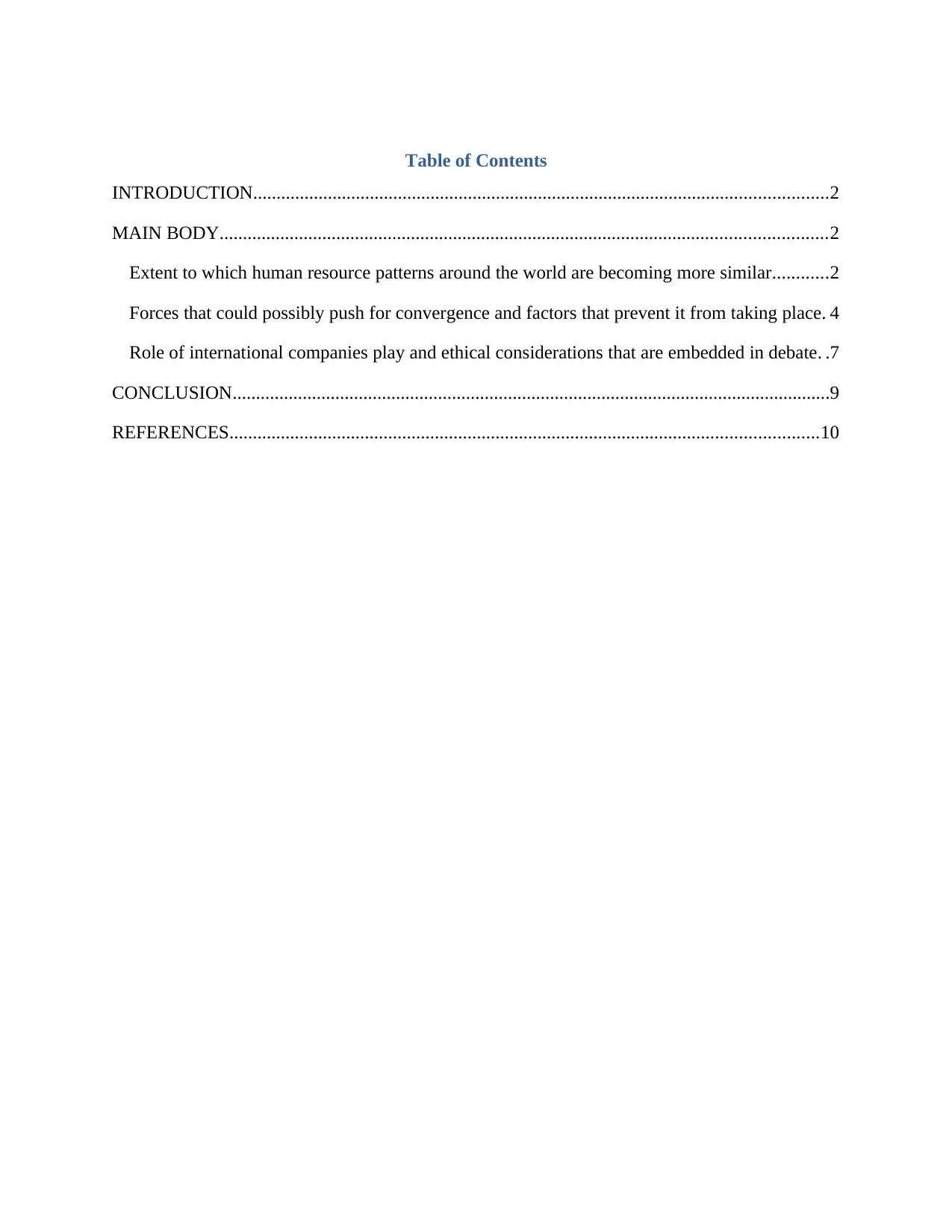
Table of Contents
INTRODUCTION...........................................................................................................................2
MAIN BODY..................................................................................................................................2
Extent to which human resource patterns around the world are becoming more similar............2
Forces that could possibly push for convergence and factors that prevent it from taking place. 4
Role of international companies play and ethical considerations that are embedded in debate. .7
CONCLUSION................................................................................................................................9
REFERENCES..............................................................................................................................10
INTRODUCTION...........................................................................................................................2
MAIN BODY..................................................................................................................................2
Extent to which human resource patterns around the world are becoming more similar............2
Forces that could possibly push for convergence and factors that prevent it from taking place. 4
Role of international companies play and ethical considerations that are embedded in debate. .7
CONCLUSION................................................................................................................................9
REFERENCES..............................................................................................................................10
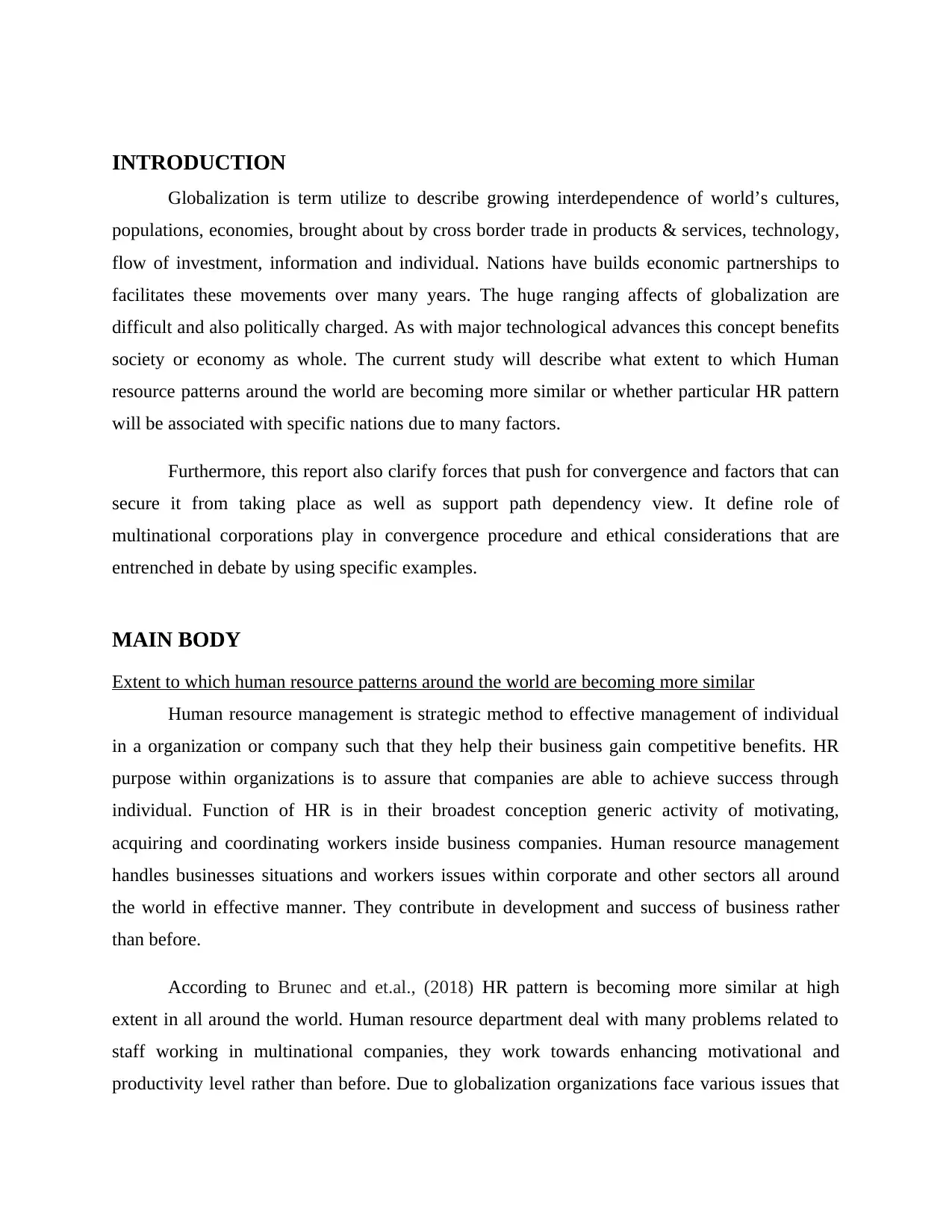
INTRODUCTION
Globalization is term utilize to describe growing interdependence of world’s cultures,
populations, economies, brought about by cross border trade in products & services, technology,
flow of investment, information and individual. Nations have builds economic partnerships to
facilitates these movements over many years. The huge ranging affects of globalization are
difficult and also politically charged. As with major technological advances this concept benefits
society or economy as whole. The current study will describe what extent to which Human
resource patterns around the world are becoming more similar or whether particular HR pattern
will be associated with specific nations due to many factors.
Furthermore, this report also clarify forces that push for convergence and factors that can
secure it from taking place as well as support path dependency view. It define role of
multinational corporations play in convergence procedure and ethical considerations that are
entrenched in debate by using specific examples.
MAIN BODY
Extent to which human resource patterns around the world are becoming more similar
Human resource management is strategic method to effective management of individual
in a organization or company such that they help their business gain competitive benefits. HR
purpose within organizations is to assure that companies are able to achieve success through
individual. Function of HR is in their broadest conception generic activity of motivating,
acquiring and coordinating workers inside business companies. Human resource management
handles businesses situations and workers issues within corporate and other sectors all around
the world in effective manner. They contribute in development and success of business rather
than before.
According to Brunec and et.al., (2018) HR pattern is becoming more similar at high
extent in all around the world. Human resource department deal with many problems related to
staff working in multinational companies, they work towards enhancing motivational and
productivity level rather than before. Due to globalization organizations face various issues that
Globalization is term utilize to describe growing interdependence of world’s cultures,
populations, economies, brought about by cross border trade in products & services, technology,
flow of investment, information and individual. Nations have builds economic partnerships to
facilitates these movements over many years. The huge ranging affects of globalization are
difficult and also politically charged. As with major technological advances this concept benefits
society or economy as whole. The current study will describe what extent to which Human
resource patterns around the world are becoming more similar or whether particular HR pattern
will be associated with specific nations due to many factors.
Furthermore, this report also clarify forces that push for convergence and factors that can
secure it from taking place as well as support path dependency view. It define role of
multinational corporations play in convergence procedure and ethical considerations that are
entrenched in debate by using specific examples.
MAIN BODY
Extent to which human resource patterns around the world are becoming more similar
Human resource management is strategic method to effective management of individual
in a organization or company such that they help their business gain competitive benefits. HR
purpose within organizations is to assure that companies are able to achieve success through
individual. Function of HR is in their broadest conception generic activity of motivating,
acquiring and coordinating workers inside business companies. Human resource management
handles businesses situations and workers issues within corporate and other sectors all around
the world in effective manner. They contribute in development and success of business rather
than before.
According to Brunec and et.al., (2018) HR pattern is becoming more similar at high
extent in all around the world. Human resource department deal with many problems related to
staff working in multinational companies, they work towards enhancing motivational and
productivity level rather than before. Due to globalization organizations face various issues that
⊘ This is a preview!⊘
Do you want full access?
Subscribe today to unlock all pages.

Trusted by 1+ million students worldwide
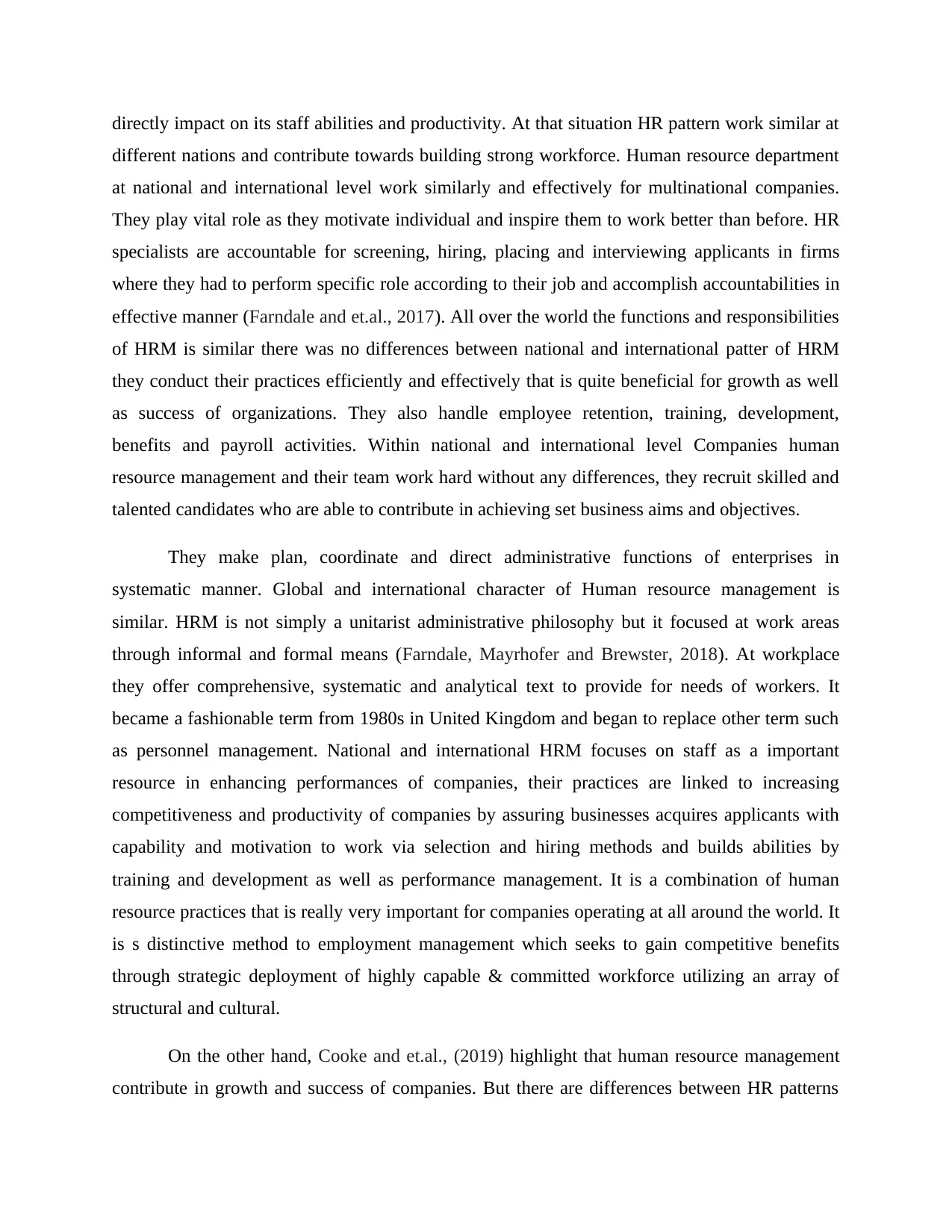
directly impact on its staff abilities and productivity. At that situation HR pattern work similar at
different nations and contribute towards building strong workforce. Human resource department
at national and international level work similarly and effectively for multinational companies.
They play vital role as they motivate individual and inspire them to work better than before. HR
specialists are accountable for screening, hiring, placing and interviewing applicants in firms
where they had to perform specific role according to their job and accomplish accountabilities in
effective manner (Farndale and et.al., 2017). All over the world the functions and responsibilities
of HRM is similar there was no differences between national and international patter of HRM
they conduct their practices efficiently and effectively that is quite beneficial for growth as well
as success of organizations. They also handle employee retention, training, development,
benefits and payroll activities. Within national and international level Companies human
resource management and their team work hard without any differences, they recruit skilled and
talented candidates who are able to contribute in achieving set business aims and objectives.
They make plan, coordinate and direct administrative functions of enterprises in
systematic manner. Global and international character of Human resource management is
similar. HRM is not simply a unitarist administrative philosophy but it focused at work areas
through informal and formal means (Farndale, Mayrhofer and Brewster, 2018). At workplace
they offer comprehensive, systematic and analytical text to provide for needs of workers. It
became a fashionable term from 1980s in United Kingdom and began to replace other term such
as personnel management. National and international HRM focuses on staff as a important
resource in enhancing performances of companies, their practices are linked to increasing
competitiveness and productivity of companies by assuring businesses acquires applicants with
capability and motivation to work via selection and hiring methods and builds abilities by
training and development as well as performance management. It is a combination of human
resource practices that is really very important for companies operating at all around the world. It
is s distinctive method to employment management which seeks to gain competitive benefits
through strategic deployment of highly capable & committed workforce utilizing an array of
structural and cultural.
On the other hand, Cooke and et.al., (2019) highlight that human resource management
contribute in growth and success of companies. But there are differences between HR patterns
different nations and contribute towards building strong workforce. Human resource department
at national and international level work similarly and effectively for multinational companies.
They play vital role as they motivate individual and inspire them to work better than before. HR
specialists are accountable for screening, hiring, placing and interviewing applicants in firms
where they had to perform specific role according to their job and accomplish accountabilities in
effective manner (Farndale and et.al., 2017). All over the world the functions and responsibilities
of HRM is similar there was no differences between national and international patter of HRM
they conduct their practices efficiently and effectively that is quite beneficial for growth as well
as success of organizations. They also handle employee retention, training, development,
benefits and payroll activities. Within national and international level Companies human
resource management and their team work hard without any differences, they recruit skilled and
talented candidates who are able to contribute in achieving set business aims and objectives.
They make plan, coordinate and direct administrative functions of enterprises in
systematic manner. Global and international character of Human resource management is
similar. HRM is not simply a unitarist administrative philosophy but it focused at work areas
through informal and formal means (Farndale, Mayrhofer and Brewster, 2018). At workplace
they offer comprehensive, systematic and analytical text to provide for needs of workers. It
became a fashionable term from 1980s in United Kingdom and began to replace other term such
as personnel management. National and international HRM focuses on staff as a important
resource in enhancing performances of companies, their practices are linked to increasing
competitiveness and productivity of companies by assuring businesses acquires applicants with
capability and motivation to work via selection and hiring methods and builds abilities by
training and development as well as performance management. It is a combination of human
resource practices that is really very important for companies operating at all around the world. It
is s distinctive method to employment management which seeks to gain competitive benefits
through strategic deployment of highly capable & committed workforce utilizing an array of
structural and cultural.
On the other hand, Cooke and et.al., (2019) highlight that human resource management
contribute in growth and success of companies. But there are differences between HR patterns
Paraphrase This Document
Need a fresh take? Get an instant paraphrase of this document with our AI Paraphraser
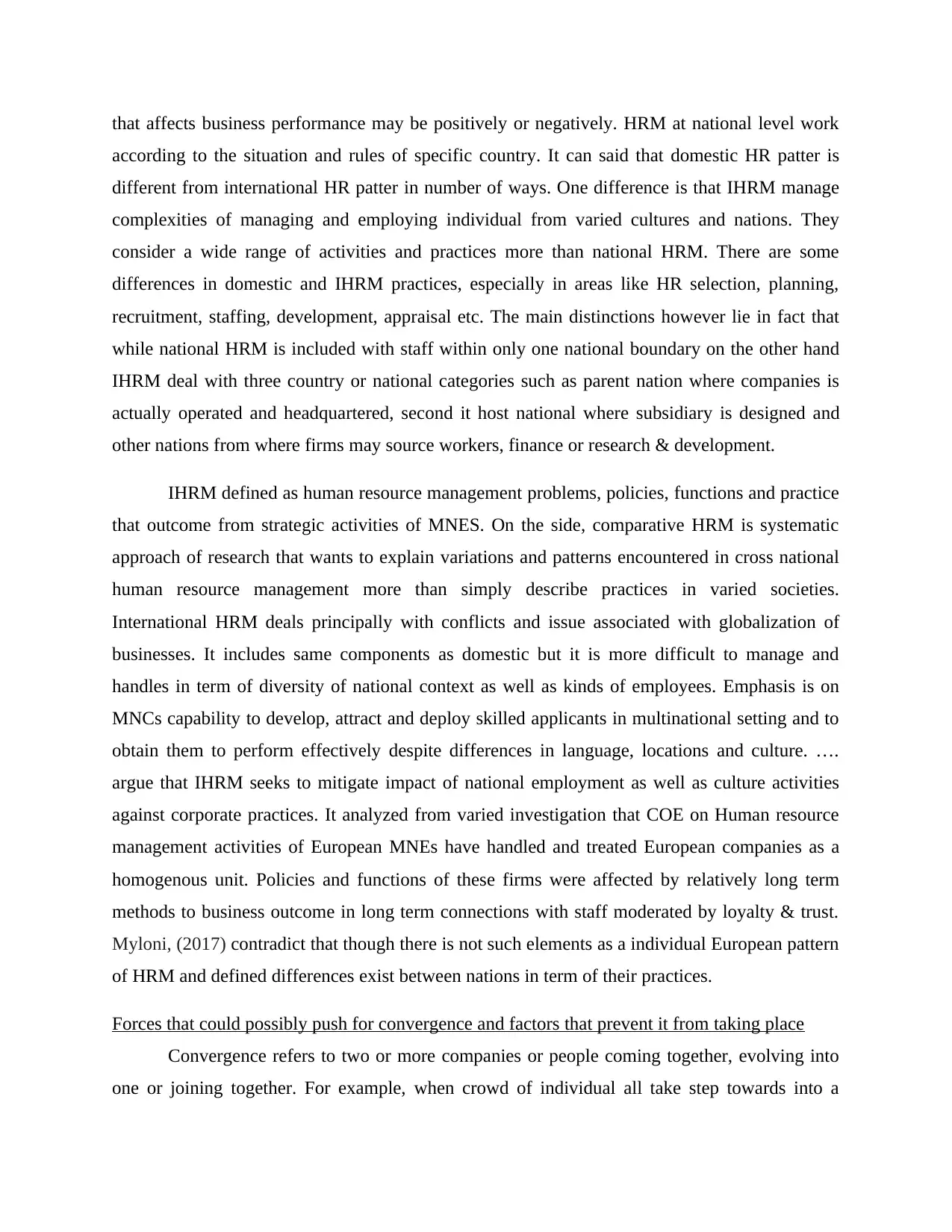
that affects business performance may be positively or negatively. HRM at national level work
according to the situation and rules of specific country. It can said that domestic HR patter is
different from international HR patter in number of ways. One difference is that IHRM manage
complexities of managing and employing individual from varied cultures and nations. They
consider a wide range of activities and practices more than national HRM. There are some
differences in domestic and IHRM practices, especially in areas like HR selection, planning,
recruitment, staffing, development, appraisal etc. The main distinctions however lie in fact that
while national HRM is included with staff within only one national boundary on the other hand
IHRM deal with three country or national categories such as parent nation where companies is
actually operated and headquartered, second it host national where subsidiary is designed and
other nations from where firms may source workers, finance or research & development.
IHRM defined as human resource management problems, policies, functions and practice
that outcome from strategic activities of MNES. On the side, comparative HRM is systematic
approach of research that wants to explain variations and patterns encountered in cross national
human resource management more than simply describe practices in varied societies.
International HRM deals principally with conflicts and issue associated with globalization of
businesses. It includes same components as domestic but it is more difficult to manage and
handles in term of diversity of national context as well as kinds of employees. Emphasis is on
MNCs capability to develop, attract and deploy skilled applicants in multinational setting and to
obtain them to perform effectively despite differences in language, locations and culture. ….
argue that IHRM seeks to mitigate impact of national employment as well as culture activities
against corporate practices. It analyzed from varied investigation that COE on Human resource
management activities of European MNEs have handled and treated European companies as a
homogenous unit. Policies and functions of these firms were affected by relatively long term
methods to business outcome in long term connections with staff moderated by loyalty & trust.
Myloni, (2017) contradict that though there is not such elements as a individual European pattern
of HRM and defined differences exist between nations in term of their practices.
Forces that could possibly push for convergence and factors that prevent it from taking place
Convergence refers to two or more companies or people coming together, evolving into
one or joining together. For example, when crowd of individual all take step towards into a
according to the situation and rules of specific country. It can said that domestic HR patter is
different from international HR patter in number of ways. One difference is that IHRM manage
complexities of managing and employing individual from varied cultures and nations. They
consider a wide range of activities and practices more than national HRM. There are some
differences in domestic and IHRM practices, especially in areas like HR selection, planning,
recruitment, staffing, development, appraisal etc. The main distinctions however lie in fact that
while national HRM is included with staff within only one national boundary on the other hand
IHRM deal with three country or national categories such as parent nation where companies is
actually operated and headquartered, second it host national where subsidiary is designed and
other nations from where firms may source workers, finance or research & development.
IHRM defined as human resource management problems, policies, functions and practice
that outcome from strategic activities of MNES. On the side, comparative HRM is systematic
approach of research that wants to explain variations and patterns encountered in cross national
human resource management more than simply describe practices in varied societies.
International HRM deals principally with conflicts and issue associated with globalization of
businesses. It includes same components as domestic but it is more difficult to manage and
handles in term of diversity of national context as well as kinds of employees. Emphasis is on
MNCs capability to develop, attract and deploy skilled applicants in multinational setting and to
obtain them to perform effectively despite differences in language, locations and culture. ….
argue that IHRM seeks to mitigate impact of national employment as well as culture activities
against corporate practices. It analyzed from varied investigation that COE on Human resource
management activities of European MNEs have handled and treated European companies as a
homogenous unit. Policies and functions of these firms were affected by relatively long term
methods to business outcome in long term connections with staff moderated by loyalty & trust.
Myloni, (2017) contradict that though there is not such elements as a individual European pattern
of HRM and defined differences exist between nations in term of their practices.
Forces that could possibly push for convergence and factors that prevent it from taking place
Convergence refers to two or more companies or people coming together, evolving into
one or joining together. For example, when crowd of individual all take step towards into a
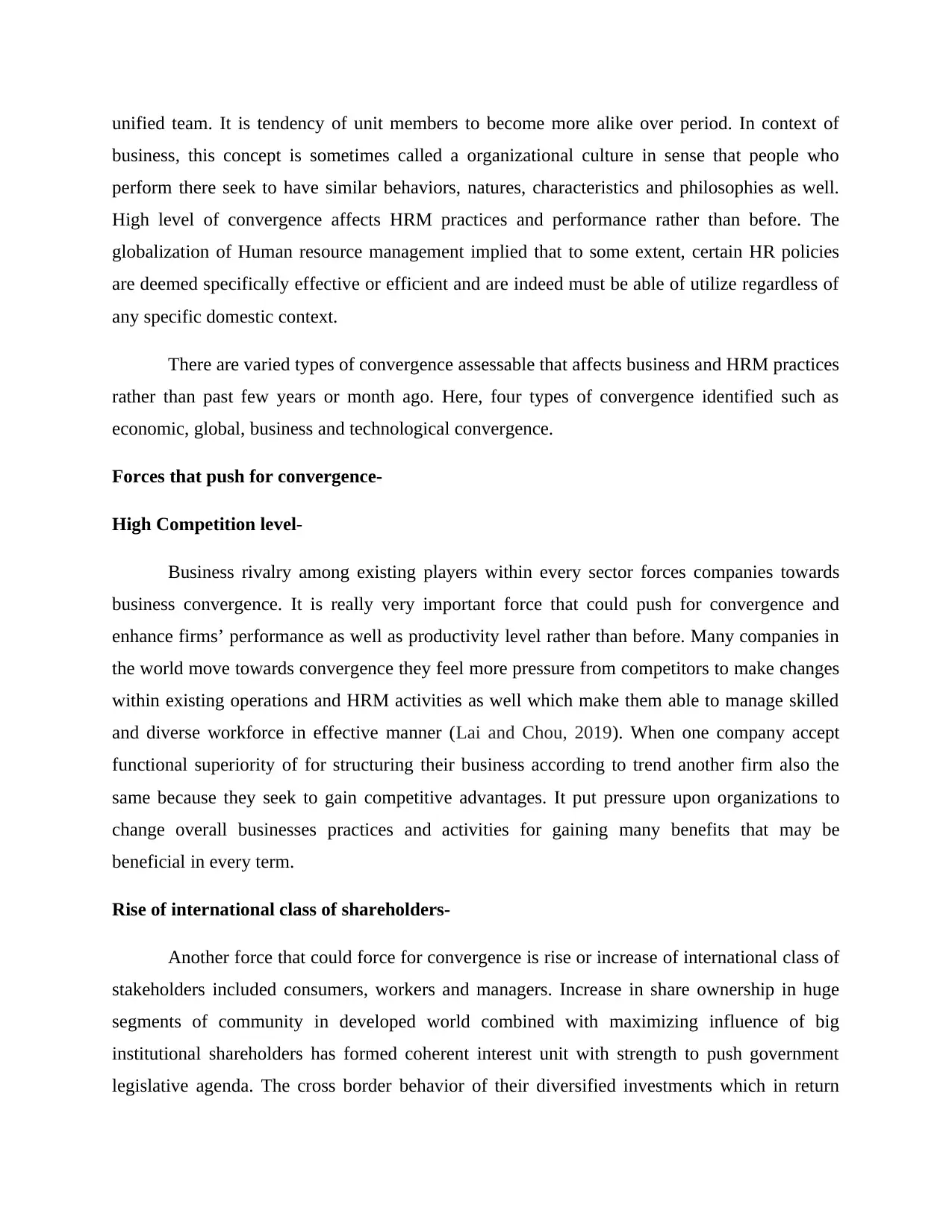
unified team. It is tendency of unit members to become more alike over period. In context of
business, this concept is sometimes called a organizational culture in sense that people who
perform there seek to have similar behaviors, natures, characteristics and philosophies as well.
High level of convergence affects HRM practices and performance rather than before. The
globalization of Human resource management implied that to some extent, certain HR policies
are deemed specifically effective or efficient and are indeed must be able of utilize regardless of
any specific domestic context.
There are varied types of convergence assessable that affects business and HRM practices
rather than past few years or month ago. Here, four types of convergence identified such as
economic, global, business and technological convergence.
Forces that push for convergence-
High Competition level-
Business rivalry among existing players within every sector forces companies towards
business convergence. It is really very important force that could push for convergence and
enhance firms’ performance as well as productivity level rather than before. Many companies in
the world move towards convergence they feel more pressure from competitors to make changes
within existing operations and HRM activities as well which make them able to manage skilled
and diverse workforce in effective manner (Lai and Chou, 2019). When one company accept
functional superiority of for structuring their business according to trend another firm also the
same because they seek to gain competitive advantages. It put pressure upon organizations to
change overall businesses practices and activities for gaining many benefits that may be
beneficial in every term.
Rise of international class of shareholders-
Another force that could force for convergence is rise or increase of international class of
stakeholders included consumers, workers and managers. Increase in share ownership in huge
segments of community in developed world combined with maximizing influence of big
institutional shareholders has formed coherent interest unit with strength to push government
legislative agenda. The cross border behavior of their diversified investments which in return
business, this concept is sometimes called a organizational culture in sense that people who
perform there seek to have similar behaviors, natures, characteristics and philosophies as well.
High level of convergence affects HRM practices and performance rather than before. The
globalization of Human resource management implied that to some extent, certain HR policies
are deemed specifically effective or efficient and are indeed must be able of utilize regardless of
any specific domestic context.
There are varied types of convergence assessable that affects business and HRM practices
rather than past few years or month ago. Here, four types of convergence identified such as
economic, global, business and technological convergence.
Forces that push for convergence-
High Competition level-
Business rivalry among existing players within every sector forces companies towards
business convergence. It is really very important force that could push for convergence and
enhance firms’ performance as well as productivity level rather than before. Many companies in
the world move towards convergence they feel more pressure from competitors to make changes
within existing operations and HRM activities as well which make them able to manage skilled
and diverse workforce in effective manner (Lai and Chou, 2019). When one company accept
functional superiority of for structuring their business according to trend another firm also the
same because they seek to gain competitive advantages. It put pressure upon organizations to
change overall businesses practices and activities for gaining many benefits that may be
beneficial in every term.
Rise of international class of shareholders-
Another force that could force for convergence is rise or increase of international class of
stakeholders included consumers, workers and managers. Increase in share ownership in huge
segments of community in developed world combined with maximizing influence of big
institutional shareholders has formed coherent interest unit with strength to push government
legislative agenda. The cross border behavior of their diversified investments which in return
⊘ This is a preview!⊘
Do you want full access?
Subscribe today to unlock all pages.

Trusted by 1+ million students worldwide
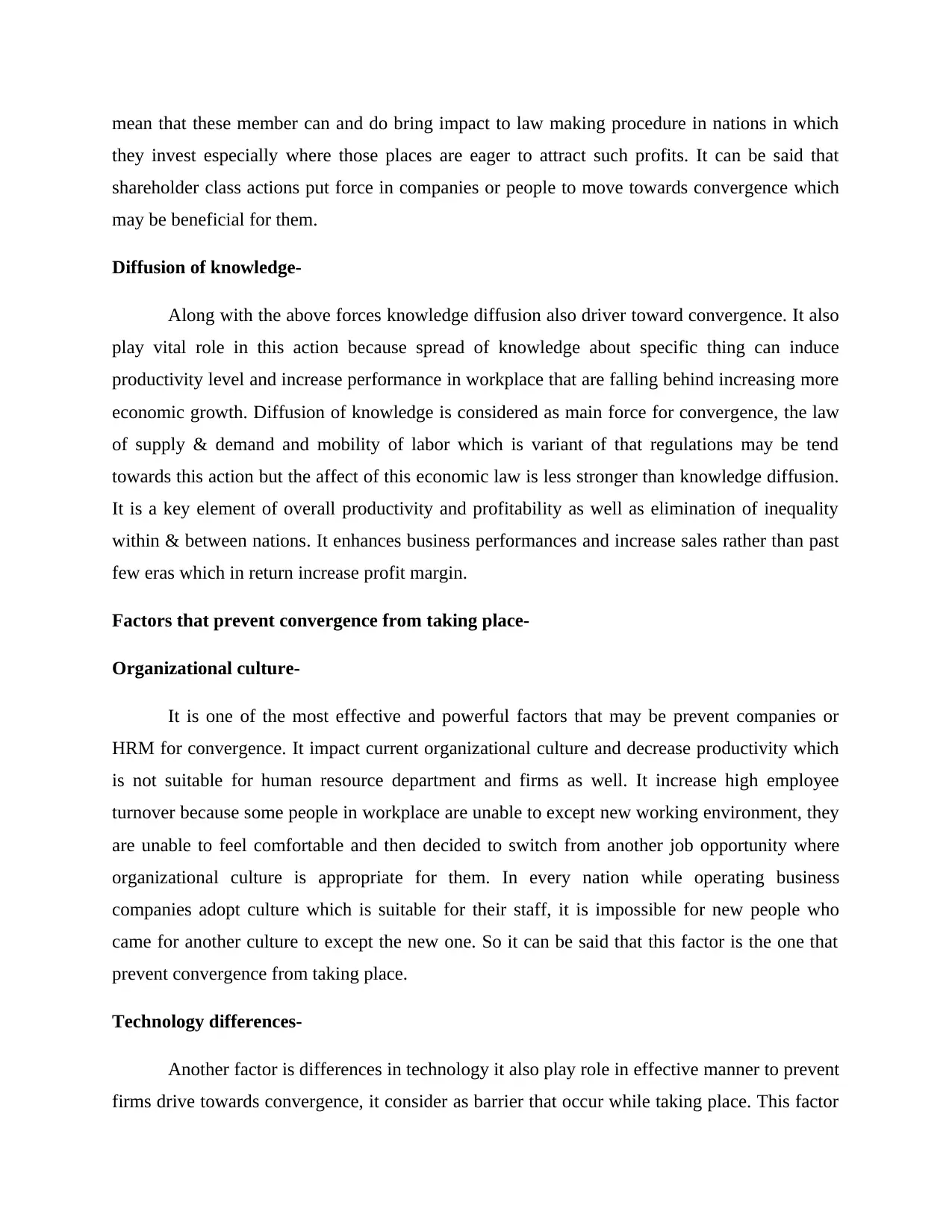
mean that these member can and do bring impact to law making procedure in nations in which
they invest especially where those places are eager to attract such profits. It can be said that
shareholder class actions put force in companies or people to move towards convergence which
may be beneficial for them.
Diffusion of knowledge-
Along with the above forces knowledge diffusion also driver toward convergence. It also
play vital role in this action because spread of knowledge about specific thing can induce
productivity level and increase performance in workplace that are falling behind increasing more
economic growth. Diffusion of knowledge is considered as main force for convergence, the law
of supply & demand and mobility of labor which is variant of that regulations may be tend
towards this action but the affect of this economic law is less stronger than knowledge diffusion.
It is a key element of overall productivity and profitability as well as elimination of inequality
within & between nations. It enhances business performances and increase sales rather than past
few eras which in return increase profit margin.
Factors that prevent convergence from taking place-
Organizational culture-
It is one of the most effective and powerful factors that may be prevent companies or
HRM for convergence. It impact current organizational culture and decrease productivity which
is not suitable for human resource department and firms as well. It increase high employee
turnover because some people in workplace are unable to except new working environment, they
are unable to feel comfortable and then decided to switch from another job opportunity where
organizational culture is appropriate for them. In every nation while operating business
companies adopt culture which is suitable for their staff, it is impossible for new people who
came for another culture to except the new one. So it can be said that this factor is the one that
prevent convergence from taking place.
Technology differences-
Another factor is differences in technology it also play role in effective manner to prevent
firms drive towards convergence, it consider as barrier that occur while taking place. This factor
they invest especially where those places are eager to attract such profits. It can be said that
shareholder class actions put force in companies or people to move towards convergence which
may be beneficial for them.
Diffusion of knowledge-
Along with the above forces knowledge diffusion also driver toward convergence. It also
play vital role in this action because spread of knowledge about specific thing can induce
productivity level and increase performance in workplace that are falling behind increasing more
economic growth. Diffusion of knowledge is considered as main force for convergence, the law
of supply & demand and mobility of labor which is variant of that regulations may be tend
towards this action but the affect of this economic law is less stronger than knowledge diffusion.
It is a key element of overall productivity and profitability as well as elimination of inequality
within & between nations. It enhances business performances and increase sales rather than past
few eras which in return increase profit margin.
Factors that prevent convergence from taking place-
Organizational culture-
It is one of the most effective and powerful factors that may be prevent companies or
HRM for convergence. It impact current organizational culture and decrease productivity which
is not suitable for human resource department and firms as well. It increase high employee
turnover because some people in workplace are unable to except new working environment, they
are unable to feel comfortable and then decided to switch from another job opportunity where
organizational culture is appropriate for them. In every nation while operating business
companies adopt culture which is suitable for their staff, it is impossible for new people who
came for another culture to except the new one. So it can be said that this factor is the one that
prevent convergence from taking place.
Technology differences-
Another factor is differences in technology it also play role in effective manner to prevent
firms drive towards convergence, it consider as barrier that occur while taking place. This factor
Paraphrase This Document
Need a fresh take? Get an instant paraphrase of this document with our AI Paraphraser
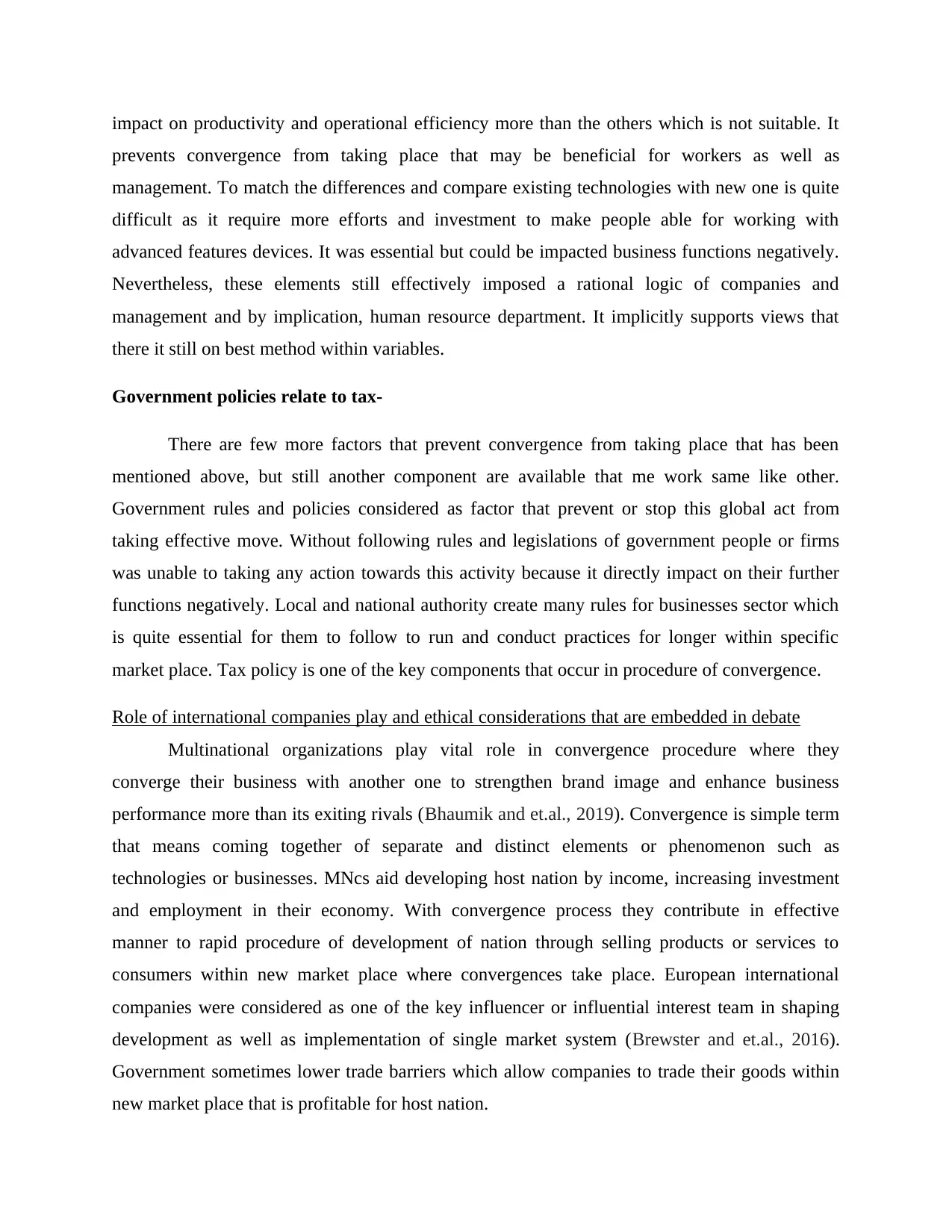
impact on productivity and operational efficiency more than the others which is not suitable. It
prevents convergence from taking place that may be beneficial for workers as well as
management. To match the differences and compare existing technologies with new one is quite
difficult as it require more efforts and investment to make people able for working with
advanced features devices. It was essential but could be impacted business functions negatively.
Nevertheless, these elements still effectively imposed a rational logic of companies and
management and by implication, human resource department. It implicitly supports views that
there it still on best method within variables.
Government policies relate to tax-
There are few more factors that prevent convergence from taking place that has been
mentioned above, but still another component are available that me work same like other.
Government rules and policies considered as factor that prevent or stop this global act from
taking effective move. Without following rules and legislations of government people or firms
was unable to taking any action towards this activity because it directly impact on their further
functions negatively. Local and national authority create many rules for businesses sector which
is quite essential for them to follow to run and conduct practices for longer within specific
market place. Tax policy is one of the key components that occur in procedure of convergence.
Role of international companies play and ethical considerations that are embedded in debate
Multinational organizations play vital role in convergence procedure where they
converge their business with another one to strengthen brand image and enhance business
performance more than its exiting rivals (Bhaumik and et.al., 2019). Convergence is simple term
that means coming together of separate and distinct elements or phenomenon such as
technologies or businesses. MNcs aid developing host nation by income, increasing investment
and employment in their economy. With convergence process they contribute in effective
manner to rapid procedure of development of nation through selling products or services to
consumers within new market place where convergences take place. European international
companies were considered as one of the key influencer or influential interest team in shaping
development as well as implementation of single market system (Brewster and et.al., 2016).
Government sometimes lower trade barriers which allow companies to trade their goods within
new market place that is profitable for host nation.
prevents convergence from taking place that may be beneficial for workers as well as
management. To match the differences and compare existing technologies with new one is quite
difficult as it require more efforts and investment to make people able for working with
advanced features devices. It was essential but could be impacted business functions negatively.
Nevertheless, these elements still effectively imposed a rational logic of companies and
management and by implication, human resource department. It implicitly supports views that
there it still on best method within variables.
Government policies relate to tax-
There are few more factors that prevent convergence from taking place that has been
mentioned above, but still another component are available that me work same like other.
Government rules and policies considered as factor that prevent or stop this global act from
taking effective move. Without following rules and legislations of government people or firms
was unable to taking any action towards this activity because it directly impact on their further
functions negatively. Local and national authority create many rules for businesses sector which
is quite essential for them to follow to run and conduct practices for longer within specific
market place. Tax policy is one of the key components that occur in procedure of convergence.
Role of international companies play and ethical considerations that are embedded in debate
Multinational organizations play vital role in convergence procedure where they
converge their business with another one to strengthen brand image and enhance business
performance more than its exiting rivals (Bhaumik and et.al., 2019). Convergence is simple term
that means coming together of separate and distinct elements or phenomenon such as
technologies or businesses. MNcs aid developing host nation by income, increasing investment
and employment in their economy. With convergence process they contribute in effective
manner to rapid procedure of development of nation through selling products or services to
consumers within new market place where convergences take place. European international
companies were considered as one of the key influencer or influential interest team in shaping
development as well as implementation of single market system (Brewster and et.al., 2016).
Government sometimes lower trade barriers which allow companies to trade their goods within
new market place that is profitable for host nation.
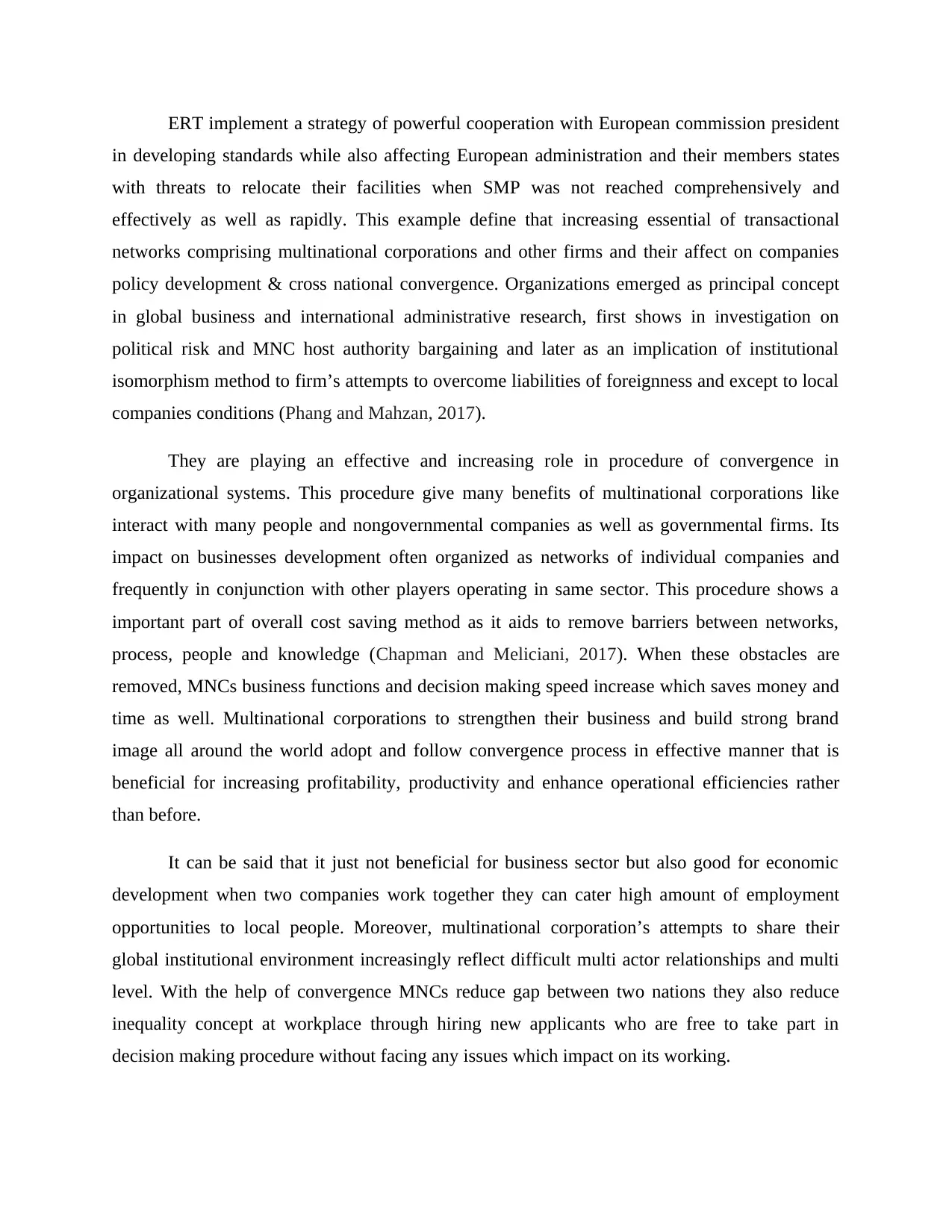
ERT implement a strategy of powerful cooperation with European commission president
in developing standards while also affecting European administration and their members states
with threats to relocate their facilities when SMP was not reached comprehensively and
effectively as well as rapidly. This example define that increasing essential of transactional
networks comprising multinational corporations and other firms and their affect on companies
policy development & cross national convergence. Organizations emerged as principal concept
in global business and international administrative research, first shows in investigation on
political risk and MNC host authority bargaining and later as an implication of institutional
isomorphism method to firm’s attempts to overcome liabilities of foreignness and except to local
companies conditions (Phang and Mahzan, 2017).
They are playing an effective and increasing role in procedure of convergence in
organizational systems. This procedure give many benefits of multinational corporations like
interact with many people and nongovernmental companies as well as governmental firms. Its
impact on businesses development often organized as networks of individual companies and
frequently in conjunction with other players operating in same sector. This procedure shows a
important part of overall cost saving method as it aids to remove barriers between networks,
process, people and knowledge (Chapman and Meliciani, 2017). When these obstacles are
removed, MNCs business functions and decision making speed increase which saves money and
time as well. Multinational corporations to strengthen their business and build strong brand
image all around the world adopt and follow convergence process in effective manner that is
beneficial for increasing profitability, productivity and enhance operational efficiencies rather
than before.
It can be said that it just not beneficial for business sector but also good for economic
development when two companies work together they can cater high amount of employment
opportunities to local people. Moreover, multinational corporation’s attempts to share their
global institutional environment increasingly reflect difficult multi actor relationships and multi
level. With the help of convergence MNCs reduce gap between two nations they also reduce
inequality concept at workplace through hiring new applicants who are free to take part in
decision making procedure without facing any issues which impact on its working.
in developing standards while also affecting European administration and their members states
with threats to relocate their facilities when SMP was not reached comprehensively and
effectively as well as rapidly. This example define that increasing essential of transactional
networks comprising multinational corporations and other firms and their affect on companies
policy development & cross national convergence. Organizations emerged as principal concept
in global business and international administrative research, first shows in investigation on
political risk and MNC host authority bargaining and later as an implication of institutional
isomorphism method to firm’s attempts to overcome liabilities of foreignness and except to local
companies conditions (Phang and Mahzan, 2017).
They are playing an effective and increasing role in procedure of convergence in
organizational systems. This procedure give many benefits of multinational corporations like
interact with many people and nongovernmental companies as well as governmental firms. Its
impact on businesses development often organized as networks of individual companies and
frequently in conjunction with other players operating in same sector. This procedure shows a
important part of overall cost saving method as it aids to remove barriers between networks,
process, people and knowledge (Chapman and Meliciani, 2017). When these obstacles are
removed, MNCs business functions and decision making speed increase which saves money and
time as well. Multinational corporations to strengthen their business and build strong brand
image all around the world adopt and follow convergence process in effective manner that is
beneficial for increasing profitability, productivity and enhance operational efficiencies rather
than before.
It can be said that it just not beneficial for business sector but also good for economic
development when two companies work together they can cater high amount of employment
opportunities to local people. Moreover, multinational corporation’s attempts to share their
global institutional environment increasingly reflect difficult multi actor relationships and multi
level. With the help of convergence MNCs reduce gap between two nations they also reduce
inequality concept at workplace through hiring new applicants who are free to take part in
decision making procedure without facing any issues which impact on its working.
⊘ This is a preview!⊘
Do you want full access?
Subscribe today to unlock all pages.

Trusted by 1+ million students worldwide
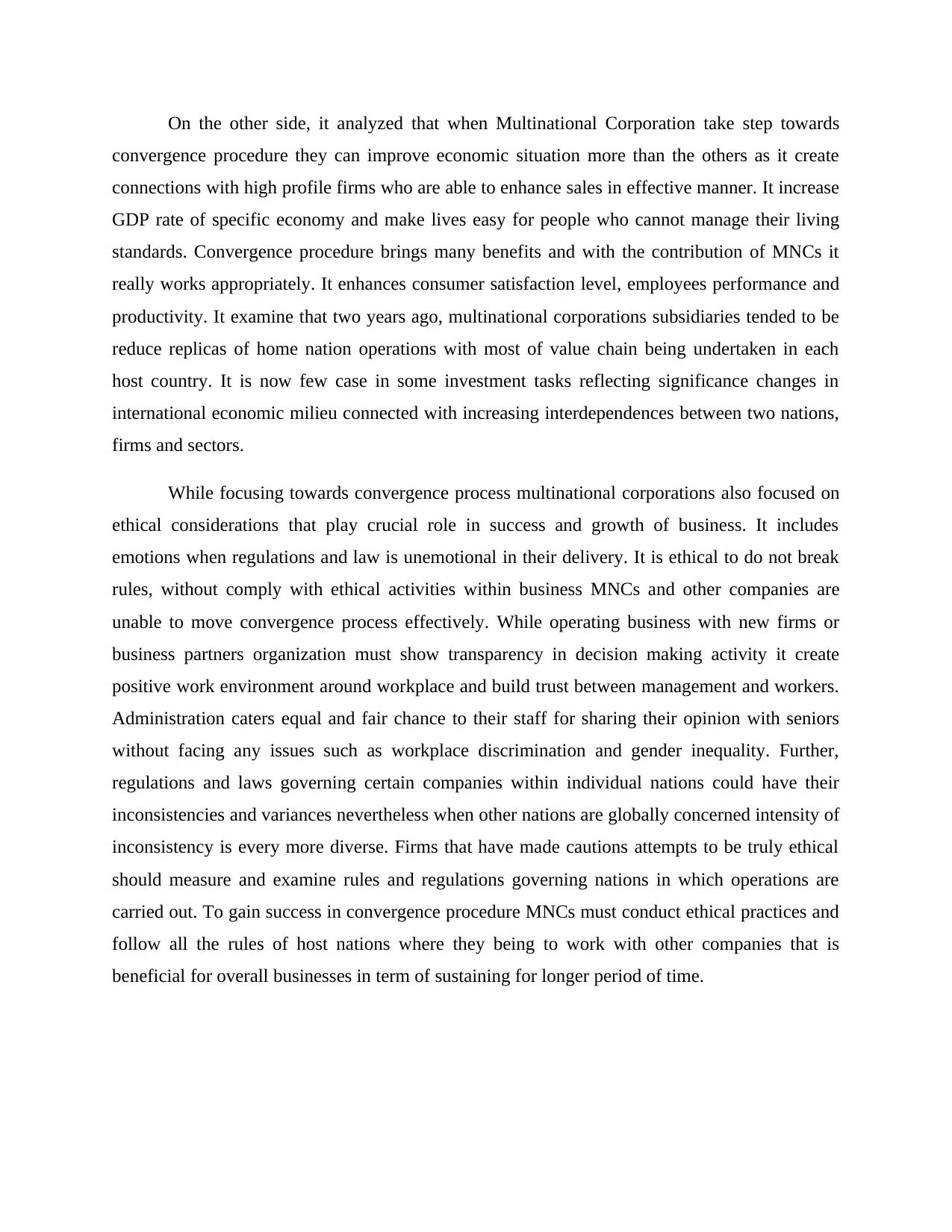
On the other side, it analyzed that when Multinational Corporation take step towards
convergence procedure they can improve economic situation more than the others as it create
connections with high profile firms who are able to enhance sales in effective manner. It increase
GDP rate of specific economy and make lives easy for people who cannot manage their living
standards. Convergence procedure brings many benefits and with the contribution of MNCs it
really works appropriately. It enhances consumer satisfaction level, employees performance and
productivity. It examine that two years ago, multinational corporations subsidiaries tended to be
reduce replicas of home nation operations with most of value chain being undertaken in each
host country. It is now few case in some investment tasks reflecting significance changes in
international economic milieu connected with increasing interdependences between two nations,
firms and sectors.
While focusing towards convergence process multinational corporations also focused on
ethical considerations that play crucial role in success and growth of business. It includes
emotions when regulations and law is unemotional in their delivery. It is ethical to do not break
rules, without comply with ethical activities within business MNCs and other companies are
unable to move convergence process effectively. While operating business with new firms or
business partners organization must show transparency in decision making activity it create
positive work environment around workplace and build trust between management and workers.
Administration caters equal and fair chance to their staff for sharing their opinion with seniors
without facing any issues such as workplace discrimination and gender inequality. Further,
regulations and laws governing certain companies within individual nations could have their
inconsistencies and variances nevertheless when other nations are globally concerned intensity of
inconsistency is every more diverse. Firms that have made cautions attempts to be truly ethical
should measure and examine rules and regulations governing nations in which operations are
carried out. To gain success in convergence procedure MNCs must conduct ethical practices and
follow all the rules of host nations where they being to work with other companies that is
beneficial for overall businesses in term of sustaining for longer period of time.
convergence procedure they can improve economic situation more than the others as it create
connections with high profile firms who are able to enhance sales in effective manner. It increase
GDP rate of specific economy and make lives easy for people who cannot manage their living
standards. Convergence procedure brings many benefits and with the contribution of MNCs it
really works appropriately. It enhances consumer satisfaction level, employees performance and
productivity. It examine that two years ago, multinational corporations subsidiaries tended to be
reduce replicas of home nation operations with most of value chain being undertaken in each
host country. It is now few case in some investment tasks reflecting significance changes in
international economic milieu connected with increasing interdependences between two nations,
firms and sectors.
While focusing towards convergence process multinational corporations also focused on
ethical considerations that play crucial role in success and growth of business. It includes
emotions when regulations and law is unemotional in their delivery. It is ethical to do not break
rules, without comply with ethical activities within business MNCs and other companies are
unable to move convergence process effectively. While operating business with new firms or
business partners organization must show transparency in decision making activity it create
positive work environment around workplace and build trust between management and workers.
Administration caters equal and fair chance to their staff for sharing their opinion with seniors
without facing any issues such as workplace discrimination and gender inequality. Further,
regulations and laws governing certain companies within individual nations could have their
inconsistencies and variances nevertheless when other nations are globally concerned intensity of
inconsistency is every more diverse. Firms that have made cautions attempts to be truly ethical
should measure and examine rules and regulations governing nations in which operations are
carried out. To gain success in convergence procedure MNCs must conduct ethical practices and
follow all the rules of host nations where they being to work with other companies that is
beneficial for overall businesses in term of sustaining for longer period of time.
Paraphrase This Document
Need a fresh take? Get an instant paraphrase of this document with our AI Paraphraser
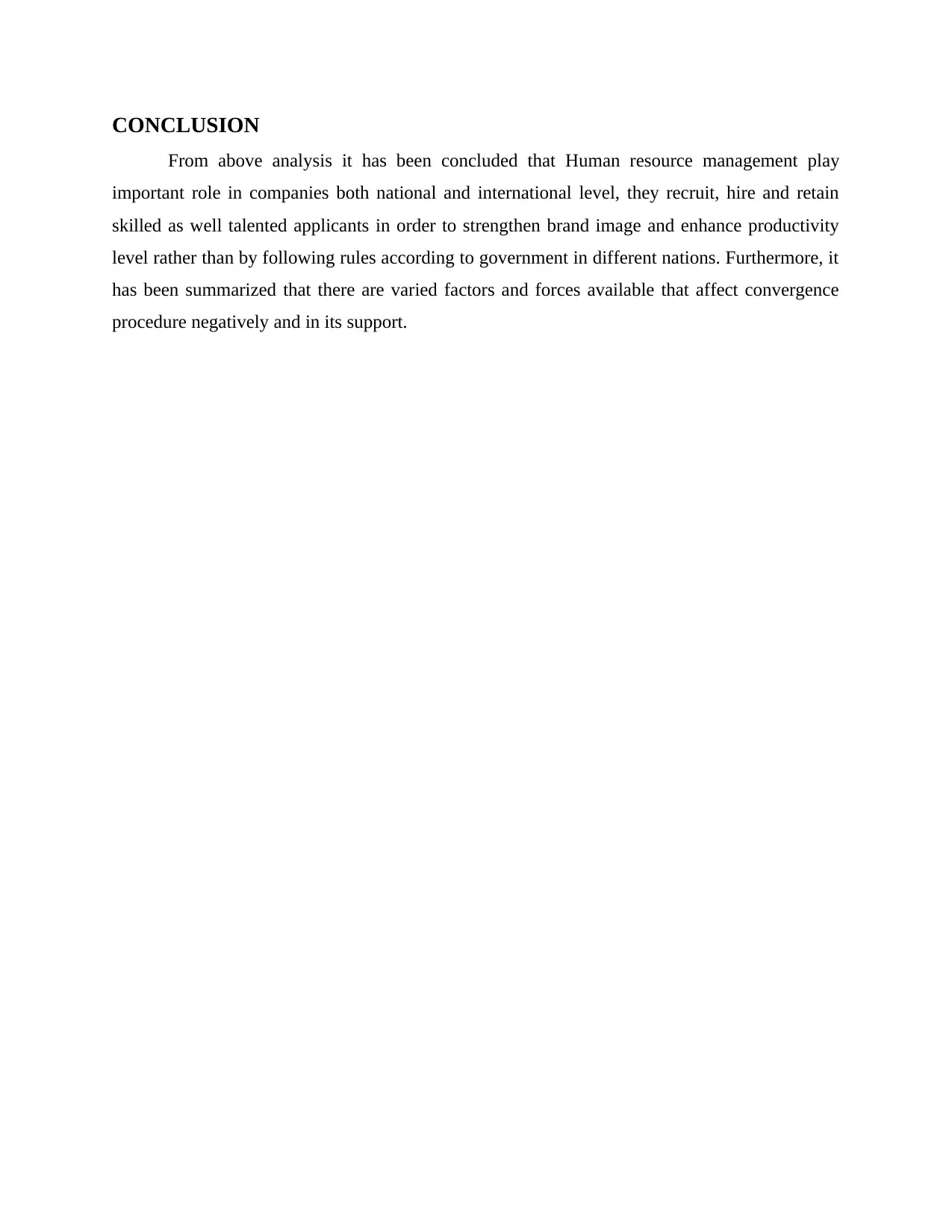
CONCLUSION
From above analysis it has been concluded that Human resource management play
important role in companies both national and international level, they recruit, hire and retain
skilled as well talented applicants in order to strengthen brand image and enhance productivity
level rather than by following rules according to government in different nations. Furthermore, it
has been summarized that there are varied factors and forces available that affect convergence
procedure negatively and in its support.
From above analysis it has been concluded that Human resource management play
important role in companies both national and international level, they recruit, hire and retain
skilled as well talented applicants in order to strengthen brand image and enhance productivity
level rather than by following rules according to government in different nations. Furthermore, it
has been summarized that there are varied factors and forces available that affect convergence
procedure negatively and in its support.
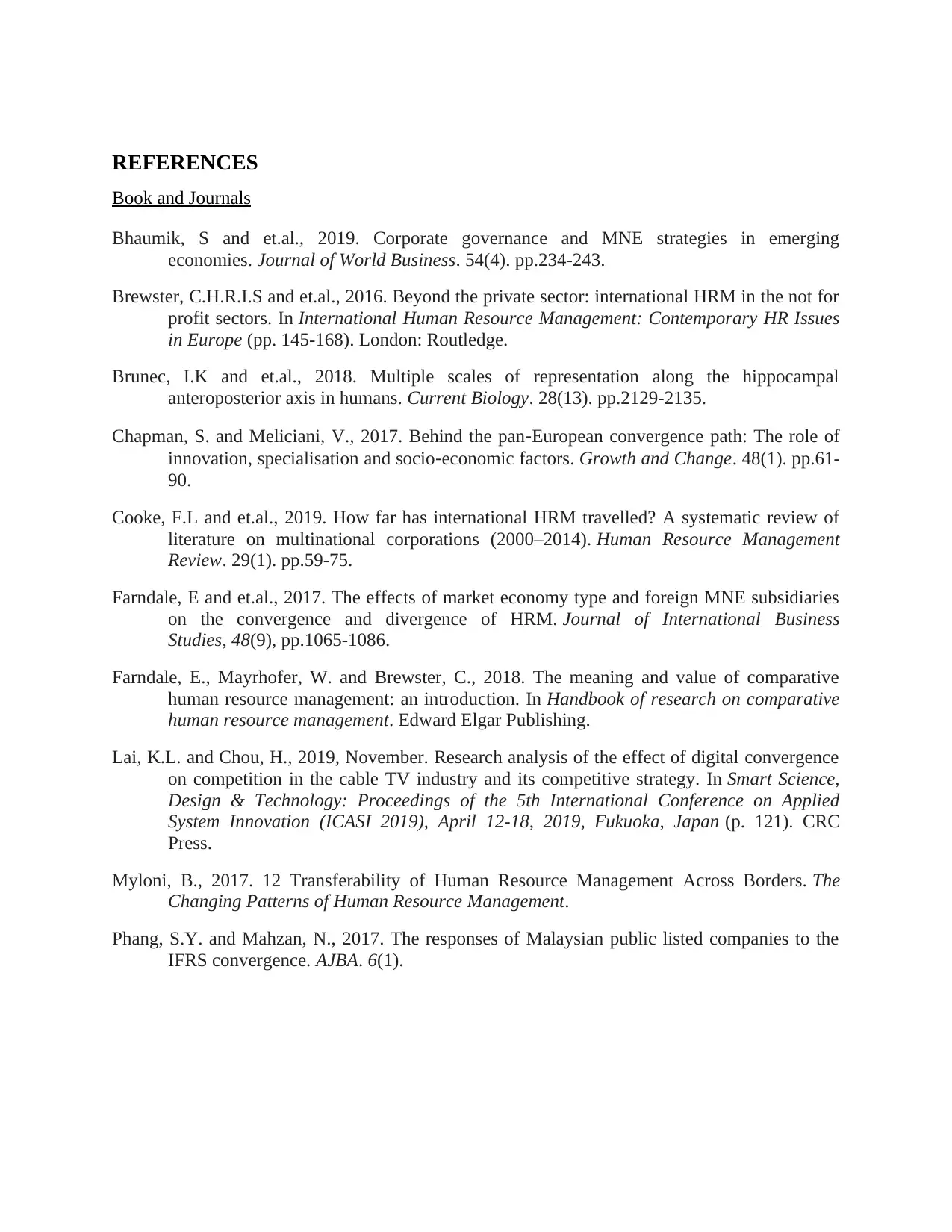
REFERENCES
Book and Journals
Bhaumik, S and et.al., 2019. Corporate governance and MNE strategies in emerging
economies. Journal of World Business. 54(4). pp.234-243.
Brewster, C.H.R.I.S and et.al., 2016. Beyond the private sector: international HRM in the not for
profit sectors. In International Human Resource Management: Contemporary HR Issues
in Europe (pp. 145-168). London: Routledge.
Brunec, I.K and et.al., 2018. Multiple scales of representation along the hippocampal
anteroposterior axis in humans. Current Biology. 28(13). pp.2129-2135.
Chapman, S. and Meliciani, V., 2017. Behind the pan‐European convergence path: The role of
innovation, specialisation and socio‐economic factors. Growth and Change. 48(1). pp.61-
90.
Cooke, F.L and et.al., 2019. How far has international HRM travelled? A systematic review of
literature on multinational corporations (2000–2014). Human Resource Management
Review. 29(1). pp.59-75.
Farndale, E and et.al., 2017. The effects of market economy type and foreign MNE subsidiaries
on the convergence and divergence of HRM. Journal of International Business
Studies, 48(9), pp.1065-1086.
Farndale, E., Mayrhofer, W. and Brewster, C., 2018. The meaning and value of comparative
human resource management: an introduction. In Handbook of research on comparative
human resource management. Edward Elgar Publishing.
Lai, K.L. and Chou, H., 2019, November. Research analysis of the effect of digital convergence
on competition in the cable TV industry and its competitive strategy. In Smart Science,
Design & Technology: Proceedings of the 5th International Conference on Applied
System Innovation (ICASI 2019), April 12-18, 2019, Fukuoka, Japan (p. 121). CRC
Press.
Myloni, B., 2017. 12 Transferability of Human Resource Management Across Borders. The
Changing Patterns of Human Resource Management.
Phang, S.Y. and Mahzan, N., 2017. The responses of Malaysian public listed companies to the
IFRS convergence. AJBA. 6(1).
Book and Journals
Bhaumik, S and et.al., 2019. Corporate governance and MNE strategies in emerging
economies. Journal of World Business. 54(4). pp.234-243.
Brewster, C.H.R.I.S and et.al., 2016. Beyond the private sector: international HRM in the not for
profit sectors. In International Human Resource Management: Contemporary HR Issues
in Europe (pp. 145-168). London: Routledge.
Brunec, I.K and et.al., 2018. Multiple scales of representation along the hippocampal
anteroposterior axis in humans. Current Biology. 28(13). pp.2129-2135.
Chapman, S. and Meliciani, V., 2017. Behind the pan‐European convergence path: The role of
innovation, specialisation and socio‐economic factors. Growth and Change. 48(1). pp.61-
90.
Cooke, F.L and et.al., 2019. How far has international HRM travelled? A systematic review of
literature on multinational corporations (2000–2014). Human Resource Management
Review. 29(1). pp.59-75.
Farndale, E and et.al., 2017. The effects of market economy type and foreign MNE subsidiaries
on the convergence and divergence of HRM. Journal of International Business
Studies, 48(9), pp.1065-1086.
Farndale, E., Mayrhofer, W. and Brewster, C., 2018. The meaning and value of comparative
human resource management: an introduction. In Handbook of research on comparative
human resource management. Edward Elgar Publishing.
Lai, K.L. and Chou, H., 2019, November. Research analysis of the effect of digital convergence
on competition in the cable TV industry and its competitive strategy. In Smart Science,
Design & Technology: Proceedings of the 5th International Conference on Applied
System Innovation (ICASI 2019), April 12-18, 2019, Fukuoka, Japan (p. 121). CRC
Press.
Myloni, B., 2017. 12 Transferability of Human Resource Management Across Borders. The
Changing Patterns of Human Resource Management.
Phang, S.Y. and Mahzan, N., 2017. The responses of Malaysian public listed companies to the
IFRS convergence. AJBA. 6(1).
⊘ This is a preview!⊘
Do you want full access?
Subscribe today to unlock all pages.

Trusted by 1+ million students worldwide
1 out of 12
Related Documents
Your All-in-One AI-Powered Toolkit for Academic Success.
+13062052269
info@desklib.com
Available 24*7 on WhatsApp / Email
![[object Object]](/_next/static/media/star-bottom.7253800d.svg)
Unlock your academic potential
Copyright © 2020–2025 A2Z Services. All Rights Reserved. Developed and managed by ZUCOL.





